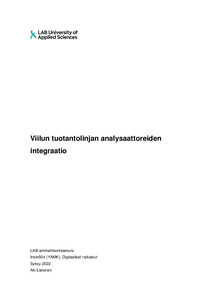Viilun tuotantolinjan analysaattoreiden integraatio
Lietonen, Aki (2022)
Lietonen, Aki
2022
All rights reserved. This publication is copyrighted. You may download, display and print it for Your own personal use. Commercial use is prohibited.
Julkaisun pysyvä osoite on
https://urn.fi/URN:NBN:fi:amk-2022112924951
https://urn.fi/URN:NBN:fi:amk-2022112924951
Tiivistelmä
Tämän opinnäytetyön aiheena oli tutkia ja kehittää Raute Oyj:n valmistamien puunjalostuskoneiden analysaattoriohjelmiin uusia ominaisuuksia, joiden avulla niiden keräämiä tietoja voitaisiin hyödyntää paremmin kokonaisella tuotantolinjalla. Tähän asti analysaattorit ovat toimineet viilun sorvauslinjalla itsenäisesti.
Tavoitteena oli luoda kommunikointiväylä tuotantolinjan eri analysaattoreiden välille, jolla tuotantolinjan loppupään tietoja voidaan kirjoittaa myös tuotantolinjan alkupäähän. Näitä tietoja voidaan hyödyntää tuotannon optimoimisessa sekä mahdollisten tuotanto-ongelmien ratkaisemisessa.
Työssä käydään läpi viilun tuotannon eri vaiheet sekä viilunsorvauslinjan analysaattoreita, niiden ominaisuuksia ja toimintaa. Analysaattoreiden ohjelmistopuolelta käydään läpi perusteet, miten ja millaisessa ympäristössä ohjelmistot toimivat. Lopuksi esitellään uusien ominaisuuksien luominen olemassa oleviin järjestelmiin.
Lopputuloksena oli valmis ja toimiva kommunikointiyhteys eri analysaattoreiden välillä ja osaa uusista ominaisuuksista päästiin myös testaamaan ihan käytännössä. Jatkossa tätä yhteyttä voidaan jatkokehittää eteenpäin ja ominaisuutta ja sen toimintoja hienosäädetään toimimaan asiakkaan tuotantolinjoilla. The subject of this Master’s thesis was to study and develop new features to the analyzer software’s used in the wood processing machineries of the Raute Corporation. These new features would be useful to utilize the data collected by the analyzers in a complete production line. Until now the analyzers have been utilized only on single purpose in the veneer peeling line.
The main objective was to create a communication protocol between two different analyzers, which would allow the analyzer at the end of the production line to write information to the analyzer at the beginning of the production line. This information can be used to optimize the production and to solve possible production problems.
In this thesis all the different phases of veneer production are introduced, also including the analyzers and their features in the veneer peeling line. The basic principles of the software of both analyzers are also introduced. The creation and testing of the new features to the existing systems are shown at the end part of the thesis.
The result of this study was a final and working communication protocol between two different analyzers. Majority of the new features was already tested in real-life situation and in the future this connection will be further developed, and the features and functions will be fine-tuned in a customer production line.
Tavoitteena oli luoda kommunikointiväylä tuotantolinjan eri analysaattoreiden välille, jolla tuotantolinjan loppupään tietoja voidaan kirjoittaa myös tuotantolinjan alkupäähän. Näitä tietoja voidaan hyödyntää tuotannon optimoimisessa sekä mahdollisten tuotanto-ongelmien ratkaisemisessa.
Työssä käydään läpi viilun tuotannon eri vaiheet sekä viilunsorvauslinjan analysaattoreita, niiden ominaisuuksia ja toimintaa. Analysaattoreiden ohjelmistopuolelta käydään läpi perusteet, miten ja millaisessa ympäristössä ohjelmistot toimivat. Lopuksi esitellään uusien ominaisuuksien luominen olemassa oleviin järjestelmiin.
Lopputuloksena oli valmis ja toimiva kommunikointiyhteys eri analysaattoreiden välillä ja osaa uusista ominaisuuksista päästiin myös testaamaan ihan käytännössä. Jatkossa tätä yhteyttä voidaan jatkokehittää eteenpäin ja ominaisuutta ja sen toimintoja hienosäädetään toimimaan asiakkaan tuotantolinjoilla.
The main objective was to create a communication protocol between two different analyzers, which would allow the analyzer at the end of the production line to write information to the analyzer at the beginning of the production line. This information can be used to optimize the production and to solve possible production problems.
In this thesis all the different phases of veneer production are introduced, also including the analyzers and their features in the veneer peeling line. The basic principles of the software of both analyzers are also introduced. The creation and testing of the new features to the existing systems are shown at the end part of the thesis.
The result of this study was a final and working communication protocol between two different analyzers. Majority of the new features was already tested in real-life situation and in the future this connection will be further developed, and the features and functions will be fine-tuned in a customer production line.
